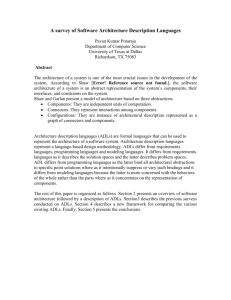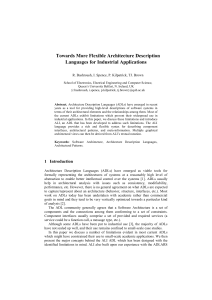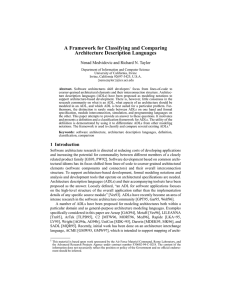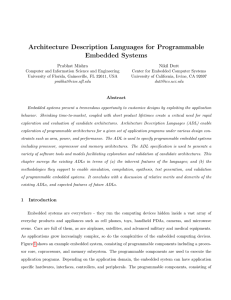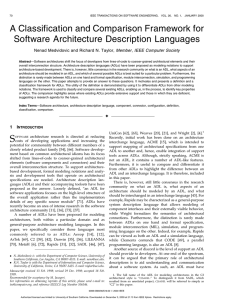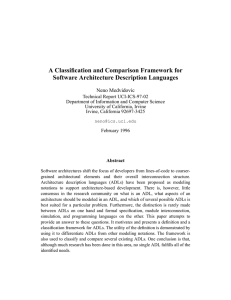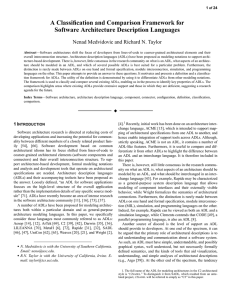Document 15364255
advertisement
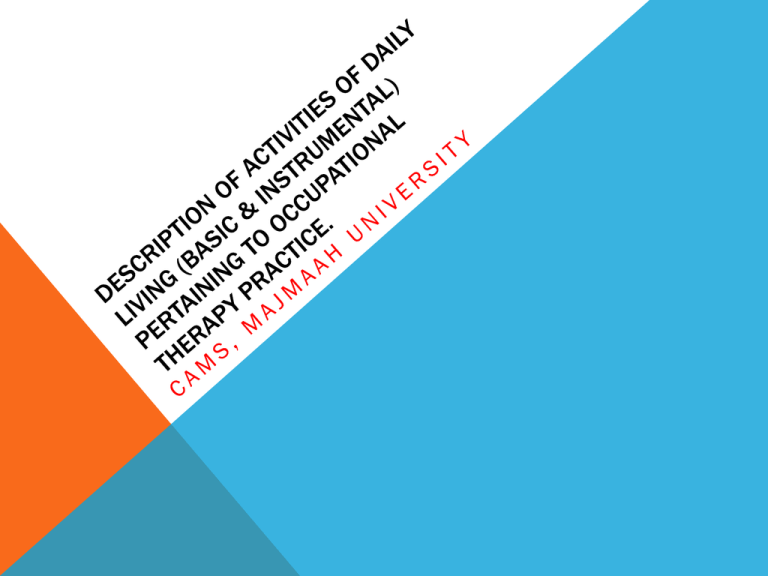
LEARNING OBJECTIVES 1.Define ADLs as it pertains to the occupational therapy practice framework. 2. Comprehend safety rules as related to ADLs. 3. Delineate between the role of occupational therapist and occupational therapist assistant. 4. Identify specific ADL compensation/ adaptation strategies. 5. Identify general ADL maintenance strategies. INTRODUCTION ADLs are defined by American occupational therapy association (AOTA) as “Activities which are oriented toward caring for one’s own body. These are also called basic activities of daily living or personal activities of daily living. Various categories of ADLs are self care (bathing, hygiene, dressing, feeding and toileting skills), functional mobility and eating. COMPONENTS OF ADLS ADL – self care, functional mobility, eating and sexual activity. 1. Performance skills. 2. Performance patterns, context and activity demands. 3. Client factors. 1. Performance skills. o Motor skills. o Process skills. Motor skills. 1. Posture , mobility , coordination strength and efforts. Process skills. 1. Energy , knowledge , organization and adaptation. COMPONENTS OF ADLS 2. Performance patterns , context and activity demands. 3. Client factors : Body functions. Mental : Global & specific Sensory & pain movement systems. Body structures. SAFETY DURING ADL INTERVENTIONS One of the primary concern during any typy of ADL is safety of our client. Therapists should monitor these hazards and provide client and care giver education. ROLE OF OCCUPATIONAL THERAPIST & OCCUPATIONAL THERAPY ASSISTANT Intervention for ADLs can be completed by OT or OT assistant. Both have adequate training and knowledge regarding most ADL tasks. The information provided regarding ADLs is primarily entry level information for both OTs and OTAs. If further training is required beyond entry level skills , this will be indicated as dysphagia. SELF CARE The definitions of self care activities according to the AOTA are as follows. Bathing : obtaining and using supplies, soaping, rinsing and drying body parts, maintaining bathing position and transferring to and from bathing positions. SELF CARE Personal hygiene and grooming : Obtaining and using supplies, removing body hair, applying and removing cosmetics, washing , drying, combing, styling, brushing and trimming hair, caring for nails, caring for skin, ears, eyes, nose, applying deodorant, cleaning mouth, brushing or removing cleaning and reinserting dental orthotics and prosthetics. SELF CARE Dressing : Selecting clothing and accessories appropriate to time of day, weather and occasion, obtaining clothing from storage area, dressing and undressing in a sequential fashion, fastening and adjust clothing and shoes and applying and removing personal devices, prosthesis and orthosis. SELF CARE Feeding : the process of bringing food from the plate or cup to the mouth. Toilet hygiene : Obtaining and using supplies, clothing management, maintaining toilet position transferring to and from toileting position, cleaning body . DEFINITIONS According to AOTA, Bowel and bladder management - It includes complete intentional control of bowel movements and urinary . Personal device care – Using cleaning and maintaining personal care items such as hearing aids contact lenses, glasses, orthotics , prosthetics, and adaptive equipment. Sleep - A period of inactivity in which one may or may not suspend consciousness. EVALUATION OF ADLS The first step of any evaluation is the completion of an interview or an occupational profile with the client. This allows the therapist to gather information regarding the client’s motivating factors, goals, discharge needs. EVALUATION OF ADLS Few examples of formal evaluations include the performance Assessment of self Care skills(PASS) , the assessment of motor and process skills (AMPS) and functional independence measure(FIM). These evaluations have been chosen because they all begin with function. THE PERFORMANCE ASSESSMENT OF SELF CARE SKILLS(PASS) PASS developed by Rogers and Holm includes 26 activities that can be evaluated as a whole or individually. Eight of the 26 items are related to ADLs as defined by AOTA, and the client is scored based on independence in completing the task, safety during the task as well as completion and outcome of task. This evaluation has two versions - clinic and home, it can be used in multiple settings. THE ASSESSMENT OF MOTOR AND PROCESS SKILLS (AMPS) The AMPS , developed by Fisher evaluates both motor and process skills through the use of ADLs. The client are scored based on their effort , safety , efficiency and independence. This tool has excellent validity and reliability as well as cultural sensitivity. FUNCTIONAL INDEPENDENCE MEASURE(FIM). FIM is the most limited of the evaluation tools listed. It is frequently used by rehabilitation facilities. It is most effective and quickly as compared to other tools. FIM is often used in an interdisciplinary format with speech , occupational therapy & physical therapy . The FIM evaluates self care , continence , mobility/locomotion , communication. REMEDIATION OF SELF CARE Remediation of self care skills include completion of an ADL session. By completing the session therapist can incorporate performance skill issues such as decreased fine motor skills or decreased cognitive skills. One technique of remediation is called backward chaining. This technique allows the client to finish the task rather than start it and stop once he or she has failed. As therapist decreases the assistance given , the client continues to gain skill and confidence, becoming independent.

